<b
Kazakh National Crafts
Kazakh National Crafts
Kazakhstan has its unique folk crafts that originated in antiquity and developed over the years. Kazakh folk crafts were formed under the influence of the nomadic culture of the Kazakh tribes. The tough and harsh life of the nomads forced Kazakh nomads to independently make everything they needed for life from what they had at hand.
Cattle breeding and hunting were the main job of the nomads, which is why products obtained from animals were used as materials for crafts: leather, wool, down, bones, horns of cattle, and small ruminants. All this led to the evolution of such crafts as felting and felt making, leather dressing, sewing leather and felt clothes, making carpets, and felt. The bones and horns of animals were used to make jewellery and some household items. Livestock leather and animal fur were used to make a wide variety of household items, from winter clothing and military armour to horse harnesses. Felt making is one of the most important and ancient Kazakh crafts.
Kazakh wood crafts
Wood craft was another significant material that nomads worked with. From wood Kazakh made dishes, weapons, furniture, and other household items, parts for saddles, handles for working tools, various lockers, and chests were made of wood.
All these items were often decorated with ornamental wood carvings. A special place in wooden crafts is reserved for crafting Kazakh yurts and traditional Kazakh musical instruments.
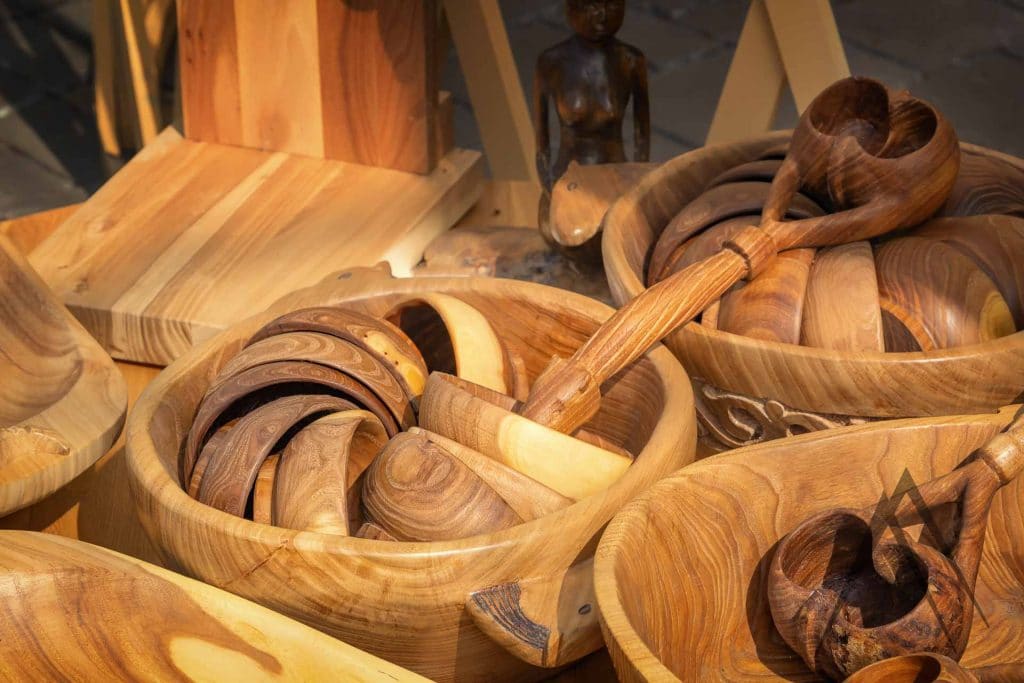
Kazakh leather crafts tradition
Leather was used to make shoes, in particular boots, because the nomads wore boots both in winter and in summer. Leather products were often decorated with embossing – this art was highly valued not only among Kazakhs but also among neighboring nations. Water containers and other daily life items were also produced from leather. Now leather is used mostly for decorative items.


Kazakh wool and felt
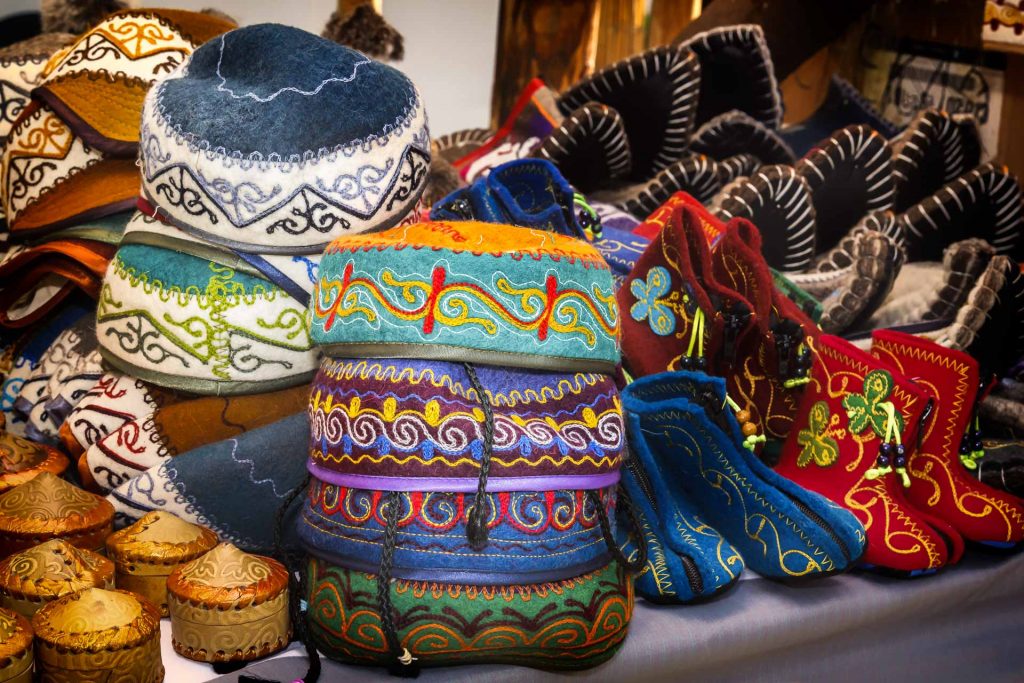
Felt is made from wool using various methods to compress the wool fibers to form a thick, durable, and warm material. The raw wool is placed upon cloth, wetted, and rolled tightly. It is then rolled, traditionally by being drawn behind a horse.
Felt products and processing remains as one of the most popular crafts in the decorative art of the great Asian steppes like Kazakhstan and other Central Asian countries. It was a major craft in Kazakh nomadic life as well as a significant work of women. Felt in Kazakhstan used mainly for flooring as a carpet well as covering a yurt. In addition, you can get a Kazakh felt souvenir toy, warm slippers, vests, scarves and much more.
Kazakh metal crafts
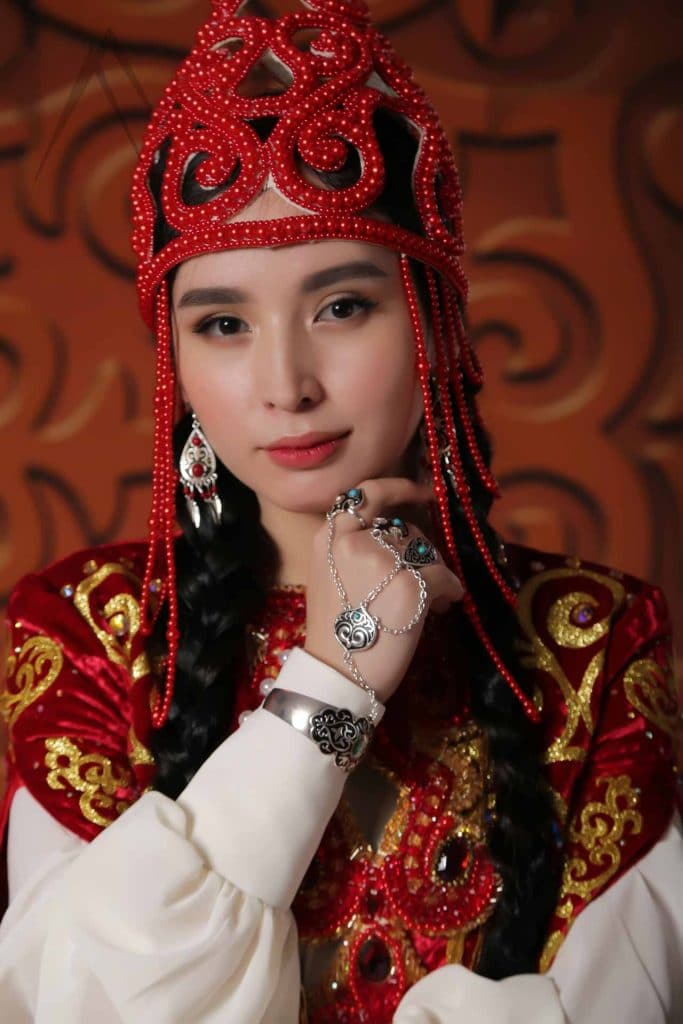
Metals are another material that Kazakh artisans used for the craft, by melting metal and making tools, dishes, and weapons from it back in the Bronze Age.
Now, while excavating, archaeologists have discovered a lot of deposits that have survived on the site of ancient settlements, where ore was mined and iron, silver, and copper were smelted.
Many items were also made of native copper. Blacksmithing was an essential skill in the life of nomads: they constantly required horseshoes, stirrups, harness parts, and harnesses for horses, knives, weapons, and other tools.
Although blacksmithing demanded a more settled lifestyle from the artisan, forges were built and worked mainly in settlements and cities of the Great Steppe. Nomads often bought finished metal products from settled blacksmiths, rather than making them themselves. Blacksmithing and jewellery craft were developed in cities such as Sygnak, Otrar, Taraz, Turkistan, and others.
Additionally, Kazakh jewellers were skilled with many techniques: forging, chasing, stamping, and others. The main material for decoration was silver, less often gold.
Silver was used to creating rings, bracelets, earrings and pendants, clothing details – buckles and buttons. Weapons, furniture, clothes, and other household items were often inlaid with silver.
Kiiz and Ala Kiyiz
Kiiz is a traditional felt carpet crafted from white, brown, or grey wool. It serves as a foundational layer in the construction of other wool products or is used to cover various parts of a yurt, such as the floor or walls.”
Kiiz, also known as ala-kiyiz, is a traditional felt carpet made by Kyrgyz and Kazakh nomadic communities. Crafted from dyed sheep’s wool, artisans lay out colourful patterns on a base of natural-colored wool, then roll and press the layers together using hot water and physical pressure.
This process melds the fibres into a single piece of felt, resulting in soft, blurred motifs that often depict symbols like horns (muyuz), animal tracks, or floral designs, each carrying cultural significance. Kiiz carpets are used to insulate and decorate yurts, serving as floor coverings or wall hangings. They are integral to Kyrgyz cultural heritage and were inscribed on UNESCO’s List of Intangible Cultural Heritage in 2012.
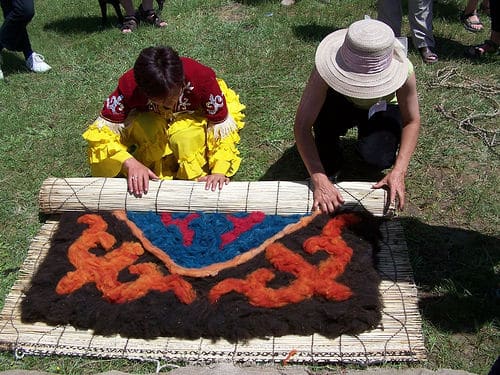
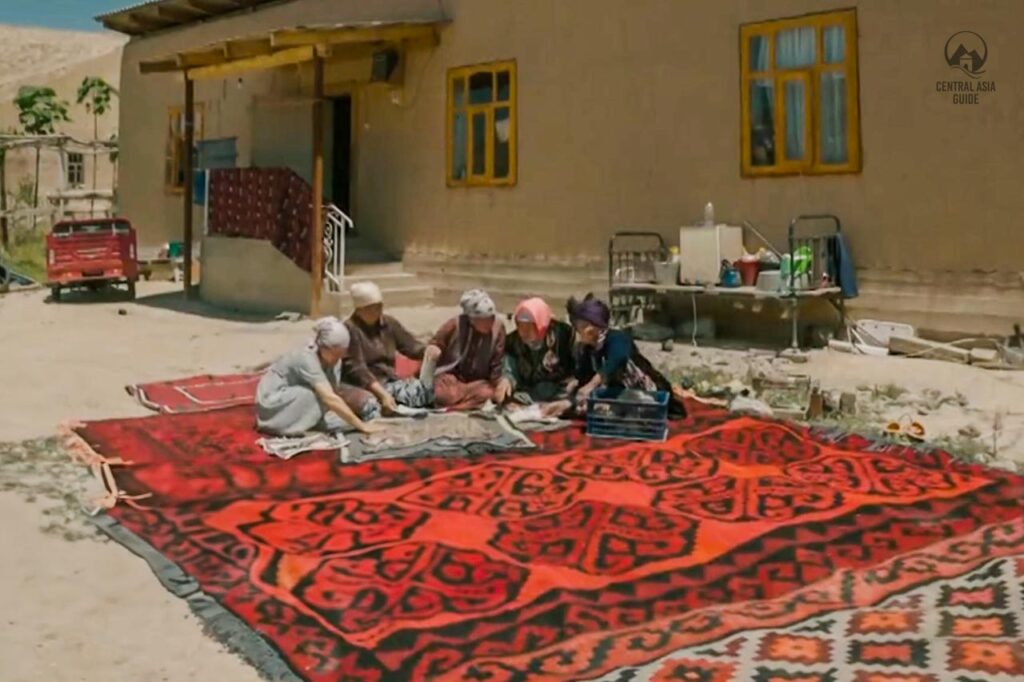
Syrmak
Syrmak is a traditional felt carpet integral to the cultural heritage of Central Asian nomadic communities, particularly among the Kazakh and Kyrgyz peoples. Crafted from natural sheep’s wool, syrmaks are known for their intricate designs and vibrant colours, serving both decorative and functional purposes within yurts.
Kazakh syrmak and Kyrgyz shyrdak are very similar traditional felt carpets, but they are not exactly the same—they share techniques and materials but differ in regional style, cultural symbolism, and construction nuances.

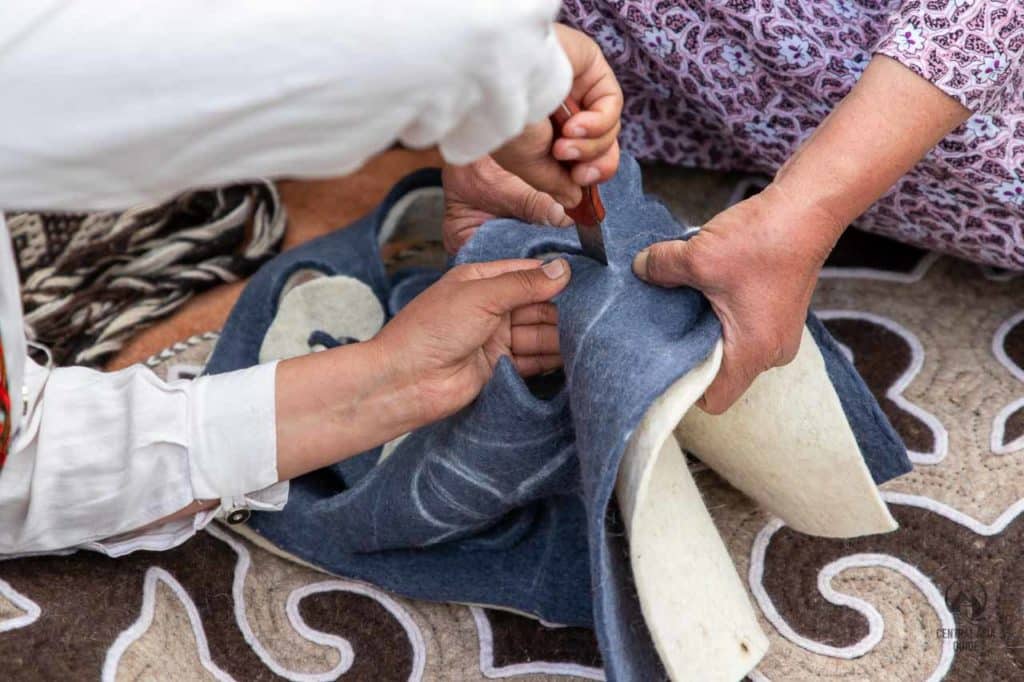
Tuzkiiz
Tuzkiiz is a decorative wall hanging, left for decorating the inside of yurts, specifically in the “tor” (region of honour) of the yurt.
Tuzkiiz’s is known for its rich embroidery, most often silk or wool yarn on velvet or felt. Further, intense, saturated hues – red, green, blue, and gold and complex motifs – flower ornamentation, animals, and symbolic signs associated with fertility, wealth, and safety.
Tuzkiiz is often used in personal and ceremonial use, typically produced as a bride’s dowry or for marking significant milestones in one’s life.
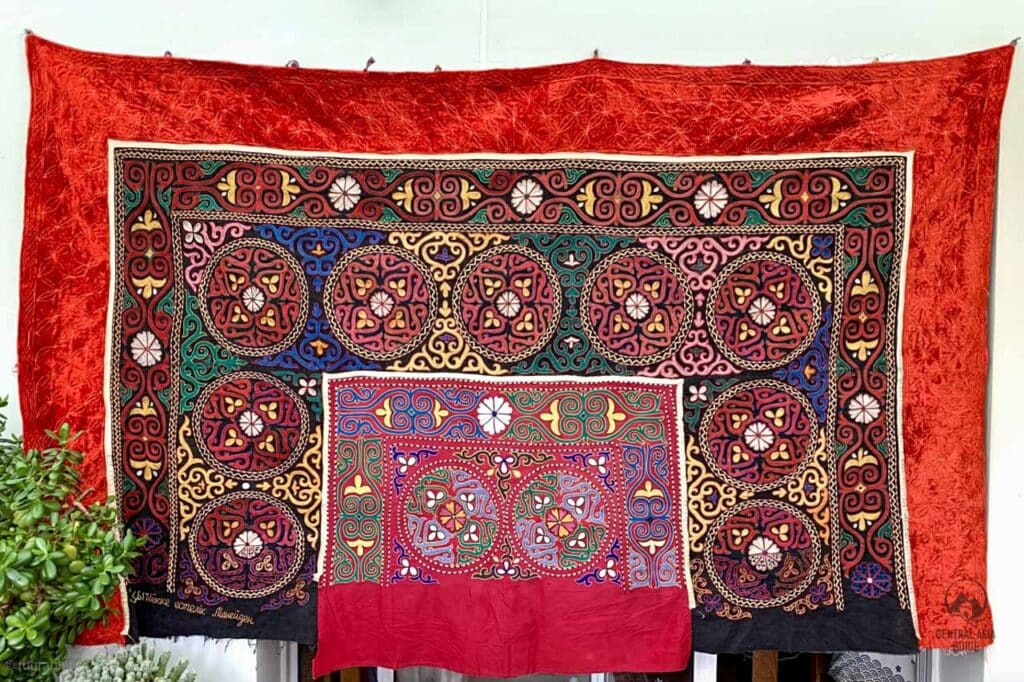
Tekemet
Tekemet is a felt rug made with compressed wool, originally sheep’s wool. It’s functional and decorative, usually on yurt floors and walls.
Tekemet is marked by its thickness, coarse texture – ideal for insulation and warmth in harsh steppe conditions as well as geometric and symbolic patterns – often in bold colours like red, black, and white. Moreover, the natural pigments – derived from plant and mineral sources. Additionally, motifs represent Kazakh cosmology, nature (horns, animals, mountains), and symbols of protection.
The production process is diligent: wool gets washed, dyed, stacked, submerged in boiling water, rolled and pressed, at times by a women’s group that sing ancient songs during the process.
Other Central Asian Crafts
Uzbek Silk Production in Margilan
In the early days, silk was considered a luxury and Margilan was the silk capital of todays Uzbekistan. Silk was the most valuable material, that was practiced for the generation of money, as a tribute, and as a means of payment.
Uzbek Suzani Culture
Within the remarkable traditions of Uzbek art, a special place takes an artistic design of fabrics suzani. Uzbekistan is famed for its suzani: decorative silk embroideries, striking imagination with bright colors, and a variety of exquisite patterns.
Page updated: 2.5.2025